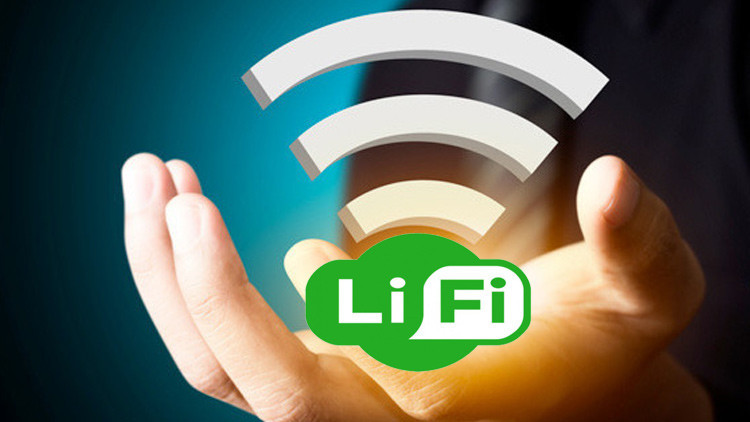Whenever you are working some thing important on your smart phone or Laptop and all of a sudden your friend decides to watch the next coming episode of Game of Thrones online and in streaming mode. So now here goes off the bandwidth. LIFI or Light Fidelity is now one of the Future solutions to the wireless communications, while promising a very high speed and data rates. so no doubt we can say , LIFI Future of Wireless Communication and Internet.
The data travels over the radio waves. The problem arises when these waves occupy that vary narrow path along electromagnetic Spectrum and limits the available bandwidth to the connected devices. So what is the solution ?. Creating a new spectrum is not a viable option. So it is now time to harness the power of light and use it for high bandwidth data transfer. Are you thinking that , it’s a right time now ?.
Li-Fi has the advantage of being useful in electromagnetic sensitive areas such as in aircraft cabins, hospitals and nuclear power plants without causing electromagnetic interference.
Well a lead mobile communication researcher Harald Hass thought and worked on it back 2000. This is the well known implementation currently known. The Idea actually dates back to 1880 where the idea of using light for data transmission was actively pursued.The general term visible light communication (VLC), whose history dates back to the 1880s, includes any use of the visible light portion of the electromagnetic spectrum to transmit information.

Working of LIFI (source BBC.com)
Using visible light for wireless communication allows to over come the problem of crowdness and radio spectrum limitations. LED bulbs are now being seen as an active candidates to provide the high capacity and low power wireless data communication. Light Fidelity also known as LIFI is the technology that is to be used in LED lights to stream data to wireless devices.
PureLiFi demonstrated the first commercially available Li-Fi system, the Li-1st, at the 2014 Mobile World Congress in Barcelona.
Visible light communications (VLC) works by switching the current to the LEDs off and on at a very high rate, too quick to be noticed by the human eye. Although Li-Fi LEDs would have to be kept on to transmit data, they could be dimmed to below human visibility while still emitting enough light to carry data.
The data rate by using LIFI can go up to 100 Gbps
How Lifi Light Fidelity Works
The general principle behind LIFI , is to change the intensity of light at such a high rate that is fast enough to transmit data at super speed and without creating the visual strobe effect. The change frequency is 1 MHz(megaHertz) or 1 million cycles per seconds. The data rate that it can support up till 2003 according to Hass is 100 gbps(gigabits per second) . Now it is very good as compared to early 2000 when Hass began to work on LIFI and it reached to the speed of 10 Mbps (mega bits per second). The current speed that Hass has achieved is 15 times faster then the current wifi speed.
Bg-Fi is a Li-Fi system consisting of an application for a mobile device, and a simple consumer product, like an IoT (Internet of Things) device, with color sensor, micro controller, and embedded software.
LIFI Light Fidelity is the future of Internet
As far as Security is concerned , It is said that LIFI is more secure then the wifi. The reason is simple , as light cannot penetrate through walls , so the signal stays in the room. The big shortcoming is that lights need to switched on for the access to internet or to have connectivity with the network. But there also exists a solution to this . There now exists a LIFI enabled LED that dims to a barely visible 10 % of its full power and still can transmit the data.
Future of Internet is LIFI
So now you can imagine the far extent of this technology that can now bring to the community. A single LIFI enabled light on the street lamp can be served as the Internet Hotspot in the developing areas and villages. So no doubt about declaring the LIFI Light Fidelity can be declared as the future of internet.
Li-Fi is reportedly being tested in Dubai, by UAE-based telecommunications provider, du and Zero1. Du claims to have successfully provided internet, audio and video streaming over a Li-Fi connection.
Also a reports suggests that Apple may build future iPhones with Li-Fi capabilities. A Twitter user found that within its iOS 9.1 code there were references to Li-Fi written as ‘LiFiCapability’ hinting that Apple may integrate Li-fi with iPhones in the future.
The first VLC smartphone prototype was presented at the Consumer Electronics Show in Las Vegas from January 7–10 in 2014. The phone uses SunPartner’s Wysips CONNECT, a technique that converts light waves into usable energy, making the phone capable of receiving and decoding signals without drawing on its battery. so there is no doubt in saying , LIFI Future of Wireless Communication and Internet.



